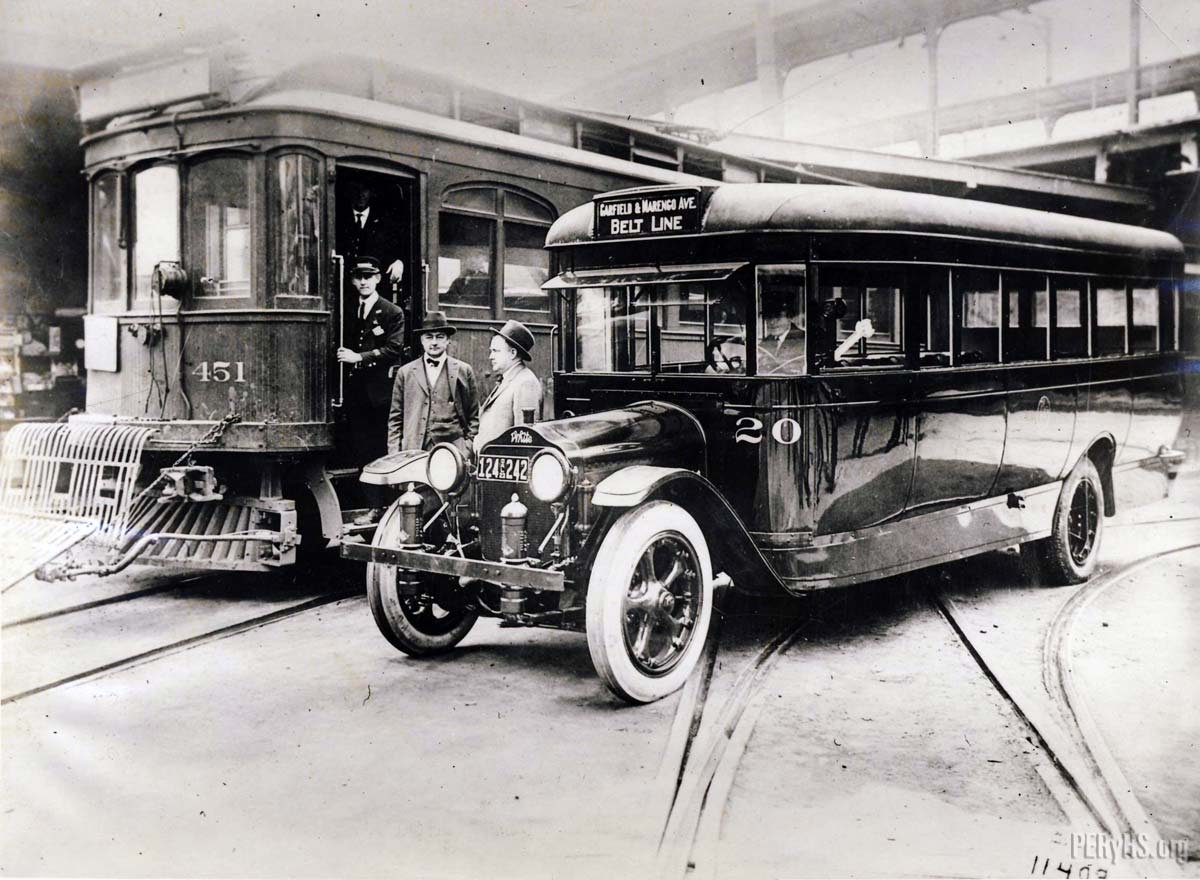PE Motor Bus 20 Meets Car 451
This is an original press release from of the Pacific Electric Railway taken by Fotograms of New York on May 17, 1923.
Mount Lowe Preservation Society Collection
The original press release statement read as follows:
Electric Railways Adopt Motor Buses on a Big Scale
Many electric railways throughout the country are employing large numbers of big buses on their feeder lines. The Pacific Electric Railway is one of the largest of its kind in America, and has taken a prominent part in leading the way in adopting motor buses on its feeder lines. This photo shows the type of bus used (a 1923 White) in comparison with the 400 class wood interurban trolley car used on the same line.
The destination sign on the bus reads Garfield & Marengo Avenue Belt Line which was in the Northern Division in Pasadena and South Pasadena.
Recent Posts
Showing 11 comments



Looks like this was shot at the 6th and Main Station. You can see the platform covers in the upper right hand side of the frame.
The PE bus garage in Pasadena stood for many years. After PE left the local transit business there, Pasadena City Lines took over the building. It was a bus facility up until about 1968, when SCRTD took over the PCL bus routes. I remember it most recently as a tire store. A few years ago, a new building was constructed on the site, but the facade of the PE structure has been saved and made part of the new construction. If know when to look, it’s visible from the Gold Line.
Hi Bob, Are you saying that this location was in Pasadena? – Steve Crise
The photo is at the PE station at 6th & Main. Presumably, after the photo shoot, the bus would have been driven to Pasadena, where it would have resided in the abovementioned bus barn. The bus was part of a group of 81 (according to Interurbans Special 61, the largest single order for motor buses as of 1923); they were used to replace streetcars on five Pasadena local lines. Note that the Garfield & Marengo Ave. Belt Line was not a streetcar replacement, but a proposed Alhambra service that didn’t materialize. These buses were assigned to Glendale, Santa Ana and Alhambra as well as Pasadena (according to “Interurbans Special 90 From Railway to Freeway.”). Also note that this was several years before General Motors got into the bus business by purchasing Yellow Coach, so GM can’t be blamed for this “bustitution.”
Ha! “Bustitution” what a great word! Learn something new everyday – now I can go to sleep happy.
“Bustitution” has been around for years–probably as far back as the 1950’s or 60’s. Not sure who created it. Another term from the “dark ages” is “Gutterliner” for diesel buses. I think it was a takeoff on “Silverliner”, which was a marketing name for a class of buses. One of my sub-categories of transit photos is taking pictures of bus lines about to be replaced by electric railways, such as Tri-Met 5 and SF Muni 8 and 32. Who would have imagined this in the bad old days? Then there’s the section of a parking lot in Sacramento that was dug up to make way for the RT Metro north line.
Bob – I’ve heard of Gutterliners before and I knew where that phrase had originated from – but Bustitution – that a totally new one on me.
This is the Seventh Street Surface Yard. Many posed photos of equipment were taken here. Many thanks to all responsible for this terrific website!
What is all that stuff just beyond the nose of 451 (under the PERY letters)? Some sort of cleaning supplies for cars going out?
What was the assignment of 451 at this time (Monrovia service?). And why might it be dispatched from the Surface Yard (if this wasn’t just staged)?
PE 451 was one of the cars acquired from LA & Redondo as part of the Great Merger. It was normally assigned to the Glendale Line. It was later upgraded for the Mt. Lowe service between LA and Altadena. Note that is was equipped with the Westinghouse MU couplers of the type later used on Hollywood and PCC cars. One of the Last assignments for cars of this group was Santa Anita Race Track specials; they were retired and scrapped in 1940.